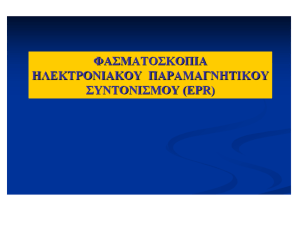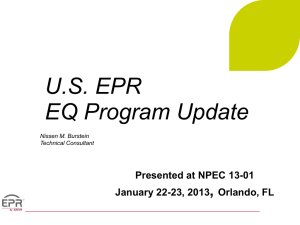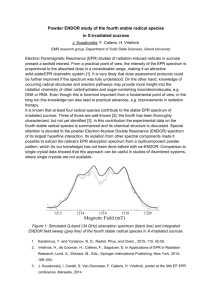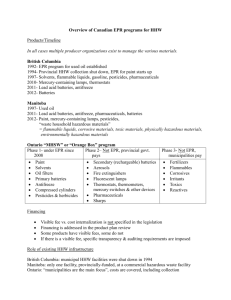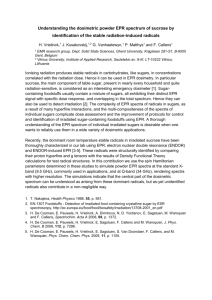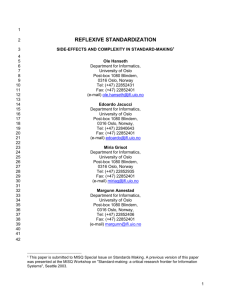papers are invited on all subjects in the field of
advertisement
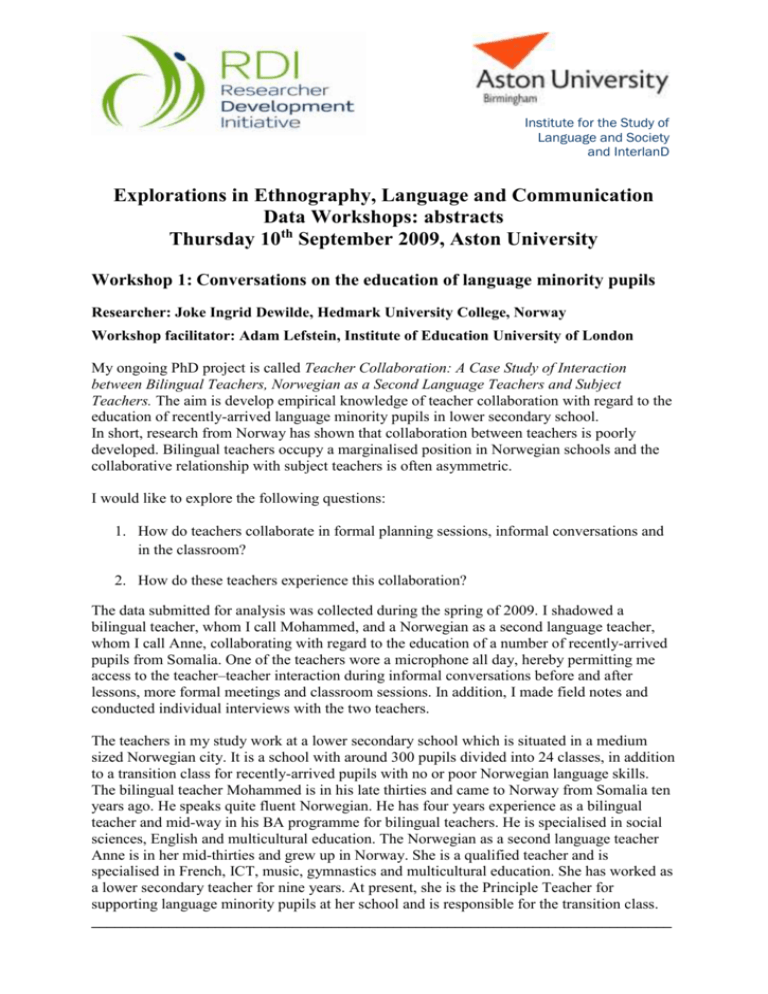
Institute for the Study of Language and Society and InterlanD Explorations in Ethnography, Language and Communication Data Workshops: abstracts Thursday 10th September 2009, Aston University Workshop 1: Conversations on the education of language minority pupils Researcher: Joke Ingrid Dewilde, Hedmark University College, Norway Workshop facilitator: Adam Lefstein, Institute of Education University of London My ongoing PhD project is called Teacher Collaboration: A Case Study of Interaction between Bilingual Teachers, Norwegian as a Second Language Teachers and Subject Teachers. The aim is develop empirical knowledge of teacher collaboration with regard to the education of recently-arrived language minority pupils in lower secondary school. In short, research from Norway has shown that collaboration between teachers is poorly developed. Bilingual teachers occupy a marginalised position in Norwegian schools and the collaborative relationship with subject teachers is often asymmetric. I would like to explore the following questions: 1. How do teachers collaborate in formal planning sessions, informal conversations and in the classroom? 2. How do these teachers experience this collaboration? The data submitted for analysis was collected during the spring of 2009. I shadowed a bilingual teacher, whom I call Mohammed, and a Norwegian as a second language teacher, whom I call Anne, collaborating with regard to the education of a number of recently-arrived pupils from Somalia. One of the teachers wore a microphone all day, hereby permitting me access to the teacher–teacher interaction during informal conversations before and after lessons, more formal meetings and classroom sessions. In addition, I made field notes and conducted individual interviews with the two teachers. The teachers in my study work at a lower secondary school which is situated in a medium sized Norwegian city. It is a school with around 300 pupils divided into 24 classes, in addition to a transition class for recently-arrived pupils with no or poor Norwegian language skills. The bilingual teacher Mohammed is in his late thirties and came to Norway from Somalia ten years ago. He speaks quite fluent Norwegian. He has four years experience as a bilingual teacher and mid-way in his BA programme for bilingual teachers. He is specialised in social sciences, English and multicultural education. The Norwegian as a second language teacher Anne is in her mid-thirties and grew up in Norway. She is a qualified teacher and is specialised in French, ICT, music, gymnastics and multicultural education. She has worked as a lower secondary teacher for nine years. At present, she is the Principle Teacher for supporting language minority pupils at her school and is responsible for the transition class. ___________________________________________________________________________ Workshop 2: Doing critical sociolinguistic ethnography at a multilingual school in Madrid. Researchers: Luisa Martín Rojo; Esther Alcalá; Diana Labajos; Laura Mijares & Ana M. Relaño Workshop facilitators: Jeff Bezemer and Carey Jewitt (Institute of Education University of London Description of the Data Data for this paper was collected as part of an ongoing one year-long critical sociolinguistics ethnography during the academic year 2008-2009, at Villababel High School. Villababel High is located in the Southeast of Madrid in a traditionally working class area. The area has a changing history of migration, from Spanish regional workers, mostly from Andalusia, Castilla-La Mancha and Extremadura, who settled in the 60s and were called “immigrants”, to the new waves of migratory communities, who have progressively been settling in the Madrid region since the 90s. Nowadays, this neighborhood is home to a million immigrants coming from about 168 countries. Type of data Our project involves: (1) a corpus of audio and video recording classroom interactions; (2) weekly ethnographic observations and fieldnotes in and outside the classroom; (3) interviews with students, teachers and school administrators; (4) institutional data; (5) educational materials used in the classroom. We will be presented classroom interactions from the two language programs implemented at Villababel High: A) The Spanish-English bilingual program sponsored by the British Council B) The language immersion program, known as Aulas de Enlace for newcomers. Villababel has 143 students (18%) enrolled in the bilingual program, which is in its 4th year in the 2008-9 academic year. The following subjects are taught in English: 1. English Literacy (5 hours a week); 2. Geography and History (3 hours a week); 3. Science (3 hours a week); Arts and Crafts (3 hours a week); Technology (3 hours a week). The language immersion program is part of the special integration measures approved by the Madrid Regional Council to attend school diversity. Aulas de Enlace (Liaison Classrooms), are aimed at students who do not speak Spanish or arrive at school with instructional delays. Students are to remain in these classes, 5 to 6 hours a day, until they achieve the adequate level of Spanish proficiency to transition to mainstream classrooms. Participants Students and teachers from two language immersion classrooms. Students come from China, Morocco, Cabo Verde, Brazil, and Rumania. Students and teachers from the Spanish-English bilingual program. Immigrant background students at this program include mostly first generation students from Rumania, Ecuador, Dominican Republic, and Peru. Aim of project: A critical sociolinguistic ethnography of language programs at Villababel High. Research questions: Who, why, how (using what languages and through which proceses) do inclusion and exclusion take place in the classroom? What is the connection between teacher’s expectations, methodology, role, teaching practices and interaction in the classsroom? Which linguistic and pedagogical ideologies underlie teaching and learning processes in the classroom? How does “bilingual education” work? What are languages used for? What is the role of languages within the educational process and the program? Is the MEC-BC program a CLIL program, in what way, and what ideologies underlie the program? Workshop 3: THE ELECTRONIC PATIENT RECORD (EPR) AS A PARTICIPANT IN THE PRIMARY HEALTHCARE CONSULTATION Researcher: Deborah Swinglehurst Workshop facilitators: Celia Roberts (Kings College London) and Sara Shaw (University College London / The Nuffield Trust) Background: This project developed from an ethnographic case study I was already engaged in, called HERO (Healthcare Electronic Records in Organisations). In this broader project, the interest is the General Practice as an organisation and the role of the EPR within it, with a particular focus on the “organisational routine” as a unit of analysis. For my PhD, I am “zooming in” on the detail of the primary care consultation and am using Discourse Analysis to focus on the detailed interaction between the clinician, the patient and the EPR. Participants: I have collected data from two of the four case study sites represented in the wider HERO project. The participants include 11 GPs, 5 nurses, 1 nurse practitioner, 1 health care assistant and 50 patients. The wider ethnography involved observation of all staff (and several hundred patients) in the study sites and collection of relevant documents relating to the EPR. Method of Data Collection: Data collection spanned approximately 4 months in each of the two study sites. The background ethnographic work involved detailed field notes of clinicians and practice staff in their interactions with the EPR, with each other and with patients. In the clinical context, this included observation of full surgeries with the participating clinicians. I then recorded 50 consultations using video (up to 3 with each clinician). Alongside the video-recording, I used screen capture software to create a parallel video of the computer monitor, displaying the patients’ EPR in real time. I used video editing software (Adobe Premiere Elements 4) to merge these two contemporaneous video streams for simultaneous playback. This opens up the dynamic “EPR-in-use” to close analysis and renders visible the EPR as both a material presence (e.g. monitor, keyboard, mouse) and a textual presence (e.g. forms, prompts, reminders and clinicians’ notes) within the consultation. The Data: Due to the terms of my NHS ethics approval I cannot share the original video data in this session. I will share transcripts of interactions between clinician and patient, incorporating talk, notes on bodily conduct and notes on the monitor display (i.e. the EPR). Aims of Research Project: My aim is to draw on concepts from Discourse Analysis to illuminate the complexity of the relationship between the clinician, the patient and the EPR in the consultation. The EPR contributes to a breach of the dyadic limits of talk and results in complex forms of participation which are underexplored and poorly understood. Ultimately my aim is to foster a more sophisticated understanding of communication in the clinical encounter than is widely held by clinicians, and to raise awareness of the ways in which macrostructures of the organisation (the GP practice) and the wider institution (the NHS) are carried through microstructures (e.g. talk) and the contribution of the EPR to this process. Questions to Explore I will bring specific questions relating to the data to the session, but the kinds of questions I am interested in exploring include: Whose voices are brought into the interaction through the EPR and how do they become re-contextualised within the interaction? Drawing on Goffman’s notion of participation framework and participation status what kind of participant is the EPR at different points in the interaction and how is this managed by patient and clinician? How and to what extent does the patient’s voice become incorporated within the EPR? How does the materiality of the EPR enable or constrain communication? How and to what extent is this drawn on as a resource by clinician or patient? What kinds of strategies are used to accommodate the materiality of the EPR within the interaction?
